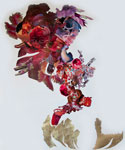 |
|
(Dancing Tongues)
My interests lie in various things 'Gothic' and science-fictional – the marginalia of post-Enlightenment literature, philosophy and science that explore encounters with the 'other side.' Today, I will show a series of images that agitate the boundaries between mythopoesis and science. These images lend themselves to a discussion about overlaps between African trickster tales and cyborg narratives. The style of this encounter is 'Deleuzo-Guattarian' – it prescribes to their technique of the 'refrain.' This technique involves sampling between and across a multitude of styles, ways of looking and cultures of feeling. Theirs is an ontology involved more with affect than intellect; it is has to do with smoothing out of differences between seemingly incompatible domains such as science, superstition, fantasy and fact by searching out symbioses and novel alliances between them. It involves a type of non-linear thinking outside of the 'box.' In this dialogue, all cultural differences (and even differences of scale, such as the micro and the macroscopic, the instantaneous and the eternal) are flattened out onto a single plane - the plane of consistency or immanence. |
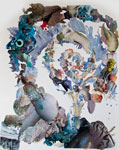 |
|
(Spiral)
Access to the plane of consistency is gained by building Bodies without Organs. These metaphorical submersibles or exploration devices require acts of participation, both imaginary and real. These undertakings concern experiences of molecular, machinic, vegetative and animal becomings. Maps of the plane of consistency depict that shadowy interface between human culture and the 'great outside' where encounters between the world of humans, animals and assorted others (such as machines, insects, atoms and spirits) occur at the level of affect. Exploring the state of becoming in order to reach the plane of consistency necessitates a journey down a spiral path into the presence of 'haecceity.' The term haecceity describes a spatial and spiral sensation of time, presence and embodiment that is orientated around becoming and affect. Haecceity, as Deleuze and Guattari write, denotes "a climate, a wind, a fog … an hour, a season, an atmosphere, an air, a life" (1988:261).
In pursuing the 'thisness, hereness and nowness' of things, tricksters and cyborgs, as Nick Land writes, "skirt the edges of the impossible, transgress against discursive orders [and] incite the unspeakable" (Land 2011:222). As agents of the liminal, they "step outside the confines of learned culture and learned and embedded language" into the domain of the indefinable other (McKenna 1993:1). |
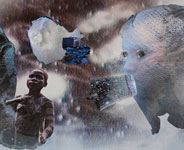 |
|
(There is no Cure for a Sudden Apparition)
African trickster tales describe engagements with strange animals and spirits. Some, particularly the Bushmen and Dogon tales, lead us (as Deleuze and Guattari write of Lovecraft's Gothic science fiction) into "strange regions inhabited by unnameable waves and indefinable particles" (1988:248). Contemporary cyborg tales (or science-fictions), they write, "have gone through a whole evolution taking [them] from animal, vegetable and mineral becomings to becomings of bacteria, viruses, molecules and things imperceptible" (1988:248). Deleuze and Guattari describe the intensification of the idea of becoming from its origins in myth to its expression in science-fiction:
A kind of evolution, or rather involution [has occurred], in which the affects of a becoming-animal are succeeded by those of a becoming-molecular, [by] microperceptions of water, air, etc. A man totters from one door to the next and disappears into thin air [transformed into] a fluid, luminous being made of fibers.' All so-called initiatory journeys include these thresholds and doors where becoming itself becomes, and where one changes becoming depending on the 'hour' of the world, the circles of hell, or the stages of a journey that sets scales, forms and cries in variation. From the howling of animals to the wailing of elements and particles.
Science fiction writer Ursula Le Guin calls myths and science-fictions "immensely flexible technologies" that enable us to make sense of the world by organizing wildly different experiences, cognitions and fantasies into radical new articulations and meanings (in Wright 1999:1). The images we are looking at represent this kind of uncanny narration or storytelling; a type of speculation that lure us with the affective promise of ecstatic becoming and evolutionary morphogenesis. |
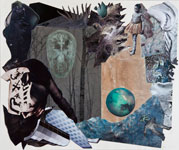 |
|
(Wilding)
The figure of the trickster is central to the mythology of nearly every traditional society and is particularly vital in African traditional lore. The trickster is the embodiment of nature itself: immanent, ambiguous and elusive. For the Ashanti of Ghana, Ananse, the spider trickster, fools with the mind's ordinary categorization of the material world and speaks the 'truth' through acts of primordial foolery. (Pelton 1980:20). In the folklore of the Fon of Benin, the trickster manifests as Legba, a lawless and rampantly sexual being who is also the 'master of language' and the many faced agent of transformation and resolution that mediates between humans and the matrix of forces and vitalities in which humans are embedded (Pelton 1980:72). For the Yoruba of Nigeria, the trickster takes the form of Eshu, the disturber of social peace who loves contradiction, fosters intercourse and frequently reveals the innermost secrets of human and animal life (Pelton 1980: 140). Ogo-Yurugu, the Pale Fox of the Dogon in Mali is a divine being of high seriousness who personifies the cosmic principle of disorder and rebellion. For the Dogon, the Pale Fox represents the centre of the cosmos whose swirling and chaotic interactions make life possible (1980:160). |
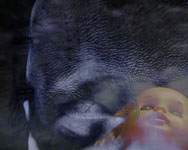 |
|
(Furface)
Trickster consciousness is schizophrenic and shamanic. The trickster entertains type of ritualised madness that is able to apprehend the contours of the world beyond the narrow sphere of cultural conditioning or even of human-centred perception. According to anthropologist Mircea Eliade, schizophrenic madness is one of the characteristics of shamanism everywhere, whether African, Asian, Aboriginal or Native American. It is worth noting that the shaman everywhere is known for his or her ability to take on the attributes of non-human lifeforms. Shamans, writes Eliade, speak a secret schizophrenic "language beyond language … a language of all nature that allows them to communicate with animals and spirits" (1989:104). The Yaminahua shamans of the Amazon basin call this convoluted language, rich in supernatural metaphor and mythical imagery, "language-twisting-twisting" (Narby, 1998:99). |
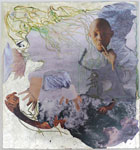 |
|
(The Transitionary)
The trickster takes the form of an animal/human/spirit/machine hybrid. Both good and/or evil and/or neither, the trickster further confounds any kind of hierarchical schemata or value-judgement. The trickster's pranks and mischief cause endless trouble but they also have a tutelary function that teaches how one perspective can be as correct as another, even when these perspectives appear to be diametrically opposed. Eshu and Legba's tales are significant in this regard. One famous Yoruba tale about Eshu relates how this trickster walked through a village wearing a bi-coloured hat (red on one side and black on the other). Afterwards, the villagers fell to arguing about the colour of the hat, becoming so enraged that they set fire to each other's houses. As Lord of misrule, Eshu plays the pipes while the village burns. Later he returns to rebuke the villagers and to reveal to them the cosmic fact that, as Goethe would put it, 'nature delights in fooling us with her illusions' and that no one point of view or 'truth' is ever the only correct one. The trickster teaches us to think schizophrenically by entertaining opposing 'truths' or realities simultaneously. Penny Miller's seminal Myths and legends of Southern Africa (1979) chronicles analogous tutelary tales from the tribes of Southern Africa in which oppositions become parallels, in which the small becomes the large, the slow turns out to be the quick, and the weak comes to be the strong. |
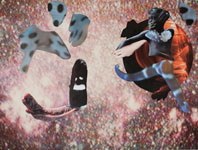 |
|
(Reaching out to Touch you)
African tricksters are often small, helpless creatures such as hares, tortoises and chameleons who manage to outwit bigger and fiercer opponents. The small and marginal … that which lies outside the structures and strictures of control … these things can 'slip through the cracks' unnoticed. Some stories about otherwise small, insignificant or weak animals show them as unexpected benefactors. The San Bushmen, for example, say that the praying mantis is responsible for gifting humans with language and fire, and the Bambara people of Mali say that the antelope taught them agriculture. The lesson here, of course, is that every part of nature is a source of vitality, even when it appears to have no value or visible power. As we knock out links in the chain of life with our rampant destruction of biodiversity, we are not only imperilling the balance of organic life but poisoning our affective relation with nature. A good encounter is invariably better than a poisoned one; that is the key to Spinoza's ethics and his notion of a vibrant materialism. The modern reality of biodiversity destruction has borne out this truth: Our psychological health as a species deteriorates in proportion to the destruction of untamed wildernesses and the animals (both mythic and real) that populate them. |
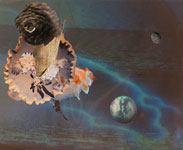 |
|
(Too Far Gone)
Operating outside the framework of right and wrong, tricksters and cyborgs are 'perverse' creatures that do not recognize rules or norms. They can be childish, greedy, lustful, and even nasty, as well as friendly, helpful, clever, and wise – often in the same tale. Always they possess amazing powers of survival. Standing at the cross-roads of world views and on the threshold between worlds, tricksters and cyborgs are free from the type of fixed (or anchored) interpretations that cling to centralized and critically recognized discursive practices. They offer hope for bridging nature/culture and human/other divides ― a critical task in a world of rapidly diminishing social and environmental returns. |
 |
|
(Cluster Reflections)
The Bushmen tales of the Mantis and his progeny are exquisitely resonant fables that illustrate the interfaces between animals and humans and invoke a deep respect for all living things. Representative of infinity and creativity, the tiny praying mantis is transformed in /Xam lore into the first trickster and holy fool. Mantis' children are "practicality" and "mind". Typical of the trickster paradigm, Mantis explores transformation, containment and the frictive and electric energy of movement and change. The mantis, with its strange alien head and almond eyes, timorous rocking motion and bizarre anthropomorphic praying front legs, is both a creature of elsewhere and a phenomenon of the everyday local African landscape. In Bushmen lore it engenders an awareness of the quantum interrelatedness of things and the potential catalysts for change. "The philosophical abstraction presented in Mantis' stories, map centrifugal movement ― outward bound and inward" (Pager 1971: 213). Mantis is a regenerative force, achieving transformations through the shaping and dismantling of the universe and its inhabitants. Certainly, one has a sense when listening to Mantis' stories of being distributed across the vast reaches of the cosmos and simultaneously of being caught within tiny bright grains of sand. |
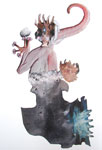 |
|
(From Out the Hydrosphere)
Another trickster protocol can be found in the cosmology of the Dogon of Mali, who have a remarkable sense of the cosmos as a vast system of correspondences, layered meanings and planes, that interlock, mirror and interrelate like curves on a spiral (Griaule & Dieterlen 1986: 23). The Dogon say that various twinned pairs of confounding Fish-human hybrid creator spirits called Nummo or Nommo hatched from a cosmic egg and created (and continue to create) the world out of their primordially-twinned oppositions. These twinned beings seem to espouse the either/or, neither/and principle of flexibility and multiplicity that Deleuze and Guattari propose as central to a vibrant materialism grounded in immanence and Spinozist ethics. Central to immanence, for these philosophers is the ability to entertain multiple truths or levels of reality simultaneously. The crazed speech they favour is typical of the Dogon trickster Nomo Ogo, who embodies what Deleuze and Guattari espouse, namely the doubleness of reality at every level. Nomo Ogo has a radically ironic imagination, saturated with oxymorons and liminal laughter (Pelton 1980: 83). He represents the irreducible ambivalence essential to fluid exchange and sublime speculation. |
 |
|
(Aqua Hoodies)
The Dogon Sigui Ceremony, as described by Griaule & Dieterlen (1986: 102) is held every sixty years to celebrate the arrival of the Nommo. Griaule & Dieterlen's descriptions of the symbolism of the event are redolently science-fictional, conjuring visions of space travel, alien beings and bizarre morphogenesis. "It is said," they write, "that the Nommo arrived in a spinning ark amid rushing air and thunderous vibrations" (1986: 102). According to Griaule & Dieterlen, the Nomo are referred to as the Masters of the Waters, the Instructors and the Monitors, depicted as amphibious cartilaginous web-fingered Annedoti (the repulsive ones) and attributed with shape-shifting, telepathic and prophetic powers (1986: 115). The Dogon mythos, so redolent in its allusions to the intrusion of "alien" technoculture, opens gateways not only into the past, but into the future as well. "Names, words, half remembered … . Do the earliest of folk heroes, or legendary characters, come not from the past but from the future," asks British SF writer Robert Holdstock (1986: 284). Carroll Brown continues this theme: "Does mythology [perhaps] originate in science? With the boundaries between the two obfuscated by our changing ontological notions and the increasingly ephemeral nature of our understanding of physical reality, original nature can be difficult to locate" (1993:170-171). Arthur C Clarke explores a similar question in Childhood's End (1953), in which he explores human religious prophecy and myth as the manifestation of a collective race memory from the future.. |
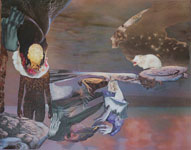 |
|
(Where the Borders are Agitated)
"In our time, a mythical time, we are all chimeras," declares Haraway (1991:150). As theorised and fabricated amalgamations of human and machine, we find ourselves entwined in an array of expanding technological networks that seem to erode any stable sense of self. At this evolutionary cross-roads, lurk Gothic werewolves, vampires and bleeding statues. The appearance of these liminal hybridities in 18th century literature, and their pop-cultural reappearance today, represents a counter-response to an on-going and relentless post-Enlightenment influx of mechanism and materialism. These are mythic creatures who participate in unnatural becomings, who rupture the boundaries between physical and non-physical, the human and the otherworldly. They are symbolic of the virulent return of primal nature, as well as the wrathful alienation of the excluded. Like werewolves and vampires Haraway's cyborgs are tricksters who are both partly material and partly "ether and quintessence;" whose myths are concerned with transgressed boundaries, potent fusions, and dangerous possibilities" (1991: 153-54). Already in the 1980's, William Gibson's seminal Neuromancer trilogy with its imagery of Gothic keeps, voudoun gods, lingering ghosts, human-machine constructs and disembodied simulations that leak, incessantly, into the 'real' situated emergent cyberculture at the nexus between African mythopoesis, Gothic monstrosity and the science-fictional cyborg. More needs to be made of this uncanny intersection where the supernatural dimensions of the 'space of flows' is revealed. |
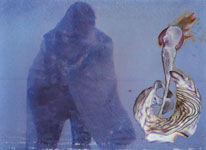 |
|
(I am No One You Know)
The contemporary situation is ripe with weird effects and affects that may serve as launching pads for imaginary voyages into the ambiguous and uncomfortable; areas that we urgently need to explore in order to rethink the apocalyptic situation of spectacular commodity culture and the spectre of the much feared 6th extinction of biological life that is, according to respected biologists, currently unfolding. Nicolas Royle notes that uncanny formulations urge us to explore and engage with the "peculiar intermingling of the familiar and unfamiliar … a sense of homeliness uprooted" (2003:1). Yet, as Royle explains, the uncanny itself is liminal, ambiguous and difficult to determine:
The uncanny is destined to elude mastery, it is what cannot be pinned down or controlled. The uncanny is never simply a question of a statement, description, or definition, but always engages a performative dimension, a maddening supplement, something unpredictable and additionally strange happening in and to what is being stated, described or defined. (2010:16) |
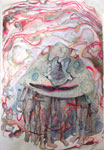 |
|
(Amphibian Ceremony)
The uncanny 'rawness' of ritual performativity and oral culture find strange parallels in contemporary dance subculture and its fascination with body-art and trance dancing. In a culture that lacks initiation rituals for its young, these uncanny activities provide access to the chaotic vitality of life, encountered at the level of pure unmediated affect.
Finding oneself confronted by the familiar rendered strangely unfamiliar is the essence of Freud's notion of the uncanny, or das unheimliche. Confronting the uncanny is necessary for healing to occur – at the level of the personal, the social and, most importantly, at the interface between humans and the natural and technical environment. The uncanny is the 'absolute outside' made manifest in the familiar; a glimpse in a mirror that reveals the shadow of an animal, an ancestor, a spirit, a machine.
The vibrant and ultimately restorative encounters that African ritual and ceremony offer are largely absent in postmodern society, yet the uncanny remains at the very heart of the modern experience. Humans today, writes Royle, are immersed in an uncanny situation that is almost beyond healing; "a situation in which we appear to have mastered nature, yet are taking ourselves and our world to pieces … in ways and speeds beyond our control" (2003:3). |
 |
|
(Chance is Rarely Pure)
From the perspective of traditional Africa, the supernatural exists in everything ― its potency is therefore simply a matter of the degree of presence. There is "no distinguishing between reality and the imagination," writes Malidoma Patrice Some; "to imagine or think something, to closely focus one's thoughts upon it, has the potential to bring that something into being" (1994:8). In the African tradition, the dead and alien are able to cohabit with the living. Animal/human metamorphoses are not only possible but, in certain instances, necessary and desirable. Thus, the tradition presents its own unique chimeric narratives that embrace becoming and transformation. Many African writers have utilized the trickster figure to express and embody the healing of social rupture. The cyborg also engages directly with this process. Both cyborgs and tricksters highlight the possibility for radical social change, operating out of mythic time but impacting directly onto the present (or "real") world. As Pelton explains, "the trickster is not an archetype but an entelechy ― an active form shaping both ends and means" (1980:105). Like Haraway's cyborg, the trickster "embodies the transforming power of the imagination that pokes, plays with and shatters assumptions of a culture's sense of origin and boundary" (1980:105). Manifesting the coincidence of opposite processes and notions in a single entity, the trickster "characterizes the peculiar unity of the liminal; that which is neither this nor that, but both" (Pelton 1980:105). |
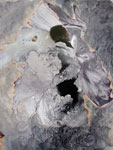 |
|
(Exercising Extraordinary Control Over Matter)
Rejecting cultural stasis through an unleashing of the forces of nature, the trickster releases the power to produce worlds in perpetual fluid transformation. The trickster is constantly hungry, a desiring machine programmed to rupture the thresholds between centre and outside, with the transformative potency to move in dimensions, planes, directions and speeds that humans cannot access. As John Mbiti writes, this rupturing of boundaries between the "real" and the "otherworldly" lies at the heart of African transformative ritual (1991: 150). From this ruptured and rapturous space, the trickster acts as the prime agent of boundary dissolution. Thence this avatar can shatter and rearrange human society into many-faceted and deliberately destabilizing matrices, destroying stasis and presenting the opportunity for re-evaluation and revelation ― typical motifs of the contemporary genre of science fiction (sf) ― in an often deeply ironic vision. By revealing underlying and multi-dimensional patterns, webs and relations of possibility and mutation in the micro- and macro-universes, the trickster figure becomes a precursor of contemporary non-linear sciences such as complexity theory, quantum mechanics and nanotechnology. |
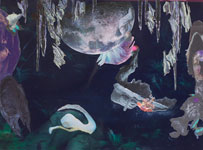 |
|
(Moonseed)
The trickster's liminality lies in its ability to maintain the rhythms of a passage across thresholds - in and out, dissolving and reordering, closing and opening- whether it be at the level of the cellular, the organism, the socius or at other temporal or dimensional levels. The tricksters' tools are playful disruption, absurd antics, seduction, irresponsibility and violent intervention. (Pelton 1980:67). There are bundles of relations, zones of intensity ― diachronic, synchronic and inchoate ― at work within the figure of the trickster. The trickster, as Pelton explains, is a nomadic outsider whose multiplicity "becomes both the source of his transforming power and the reason for his banishment from the community; a profaner of the sacred he becomes a sacred being, yet outsider, the victim of his own violations" (Pelton 1980: 145). |
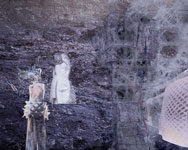 |
|
(Alien Nomads)
As an outsider who ruptures order, the trickster is a perfect figure for the literary ghetto of sf, which deals centrally with rupture. The trickster realizes that order separated from dissolution becomes immobility. Friction is necessary for movement and change by allowing channels of dissolution and (re)distribution into the centre ― in this case, allowing a revisioning and deconstruction and playful approach to accepted readings of culture and nature. In African mythology, the trickster has traditionally helped to ensure harmony with the environment and helped the community navigate through discontinuity and change by allowing a place for contingency, dissolution and renewal. The trickster thereby becomes the necessary avatar and "outsider", with which to engage the fraught contemporary relationship between humans as well as between humans and their environments. "Cyborgs," writes Donna Haraway, "do not search for pure origins." Instead, they are concerned with "revisioning the world as a coding trickster with whom we must learn to converse" (cited in Van Loon, 1996:239). |